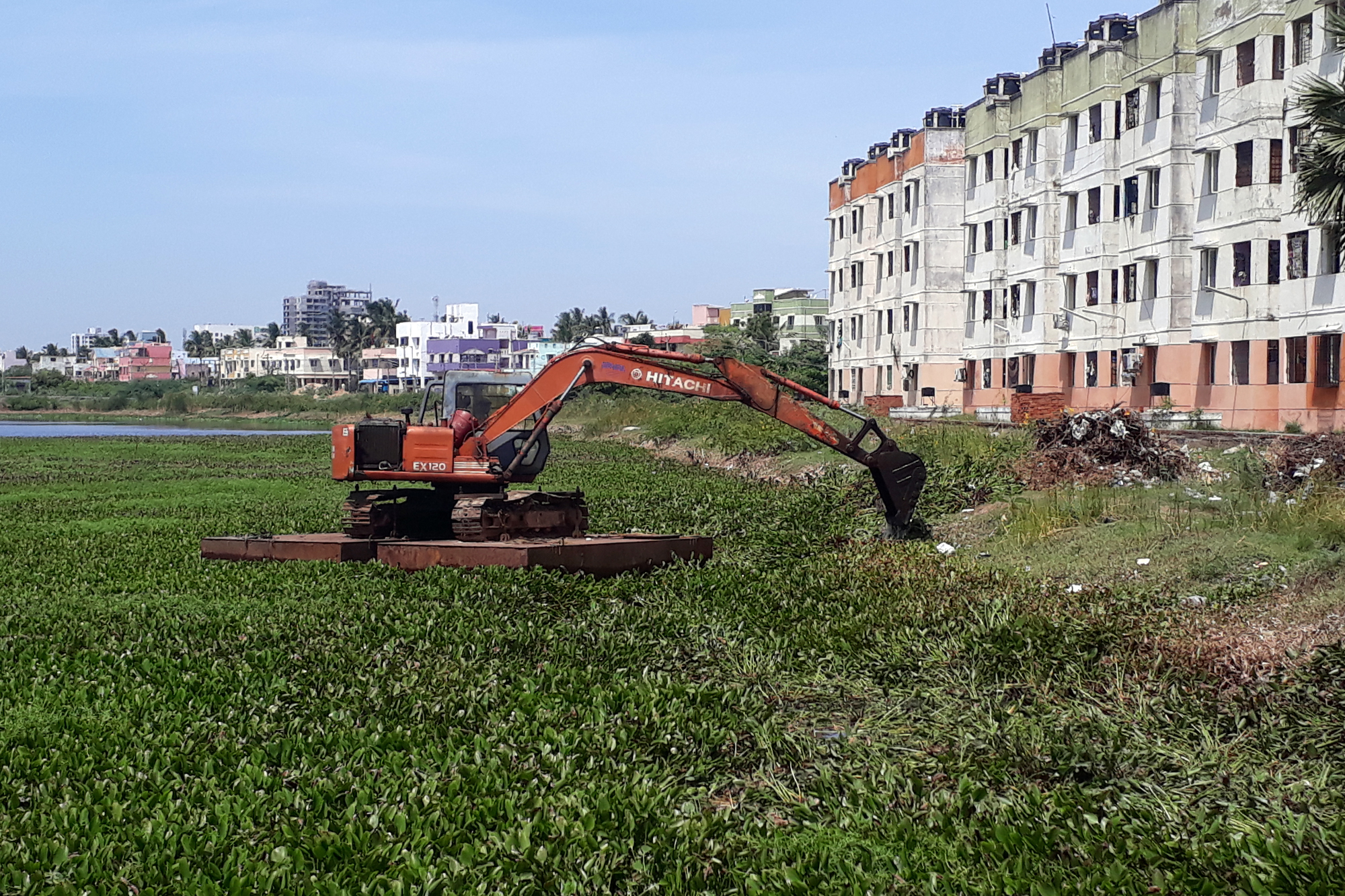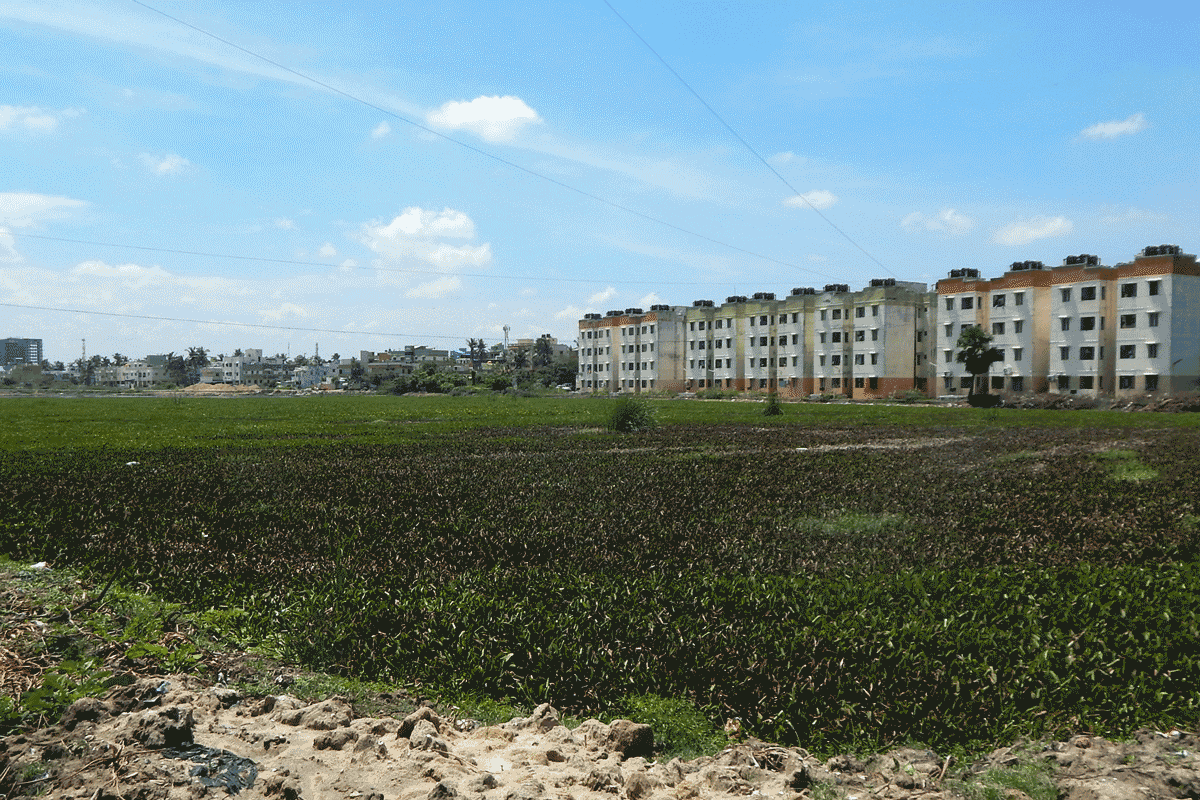A restored wetland brings hope to a flood and drought-prone Chennai
- Nature Conservation
- Ecosystem Restoration
- Wetlands
- Sustainable Livelihoods
- Community Action
- Indian Subcontinent
- Indomalaya Realm
Venkatesh Kesav and his friends, equipped with gloves, spades, and dustbins, have a weekly ritual of cleaning a 10-acre pond in the Sholinganallur area in Chennai, the capital of Tamil Nadu in southern India. Kesav, a technical staff at an engineering college, does his voluntary work of maintaining and monitoring the pond with enthusiasm and commitment.
Local communities can now wash clothes, utensils and bathe in Puducherry Keni Kulam after the wetland was restored almost a year ago. Members of the local community have been maintaining the wetland since then. “Now, when I see the kids swimming in it, I always feel like jumping in, too,” says 50-year-old Kesav.

An excavator mounted on a floating barge removes water hyacinth that had covered a major portion of the pond and choked it.
Photo by Care Earth Trust
But the state of this wetland, squeezed between roads and residential buildings in Chennai’s IT corridor, was starkly different before it was restored. Care Earth Trust, a Chennai-based NGO that works on biodiversity conservation, in particular, wetlands restoration, along with municipal authorities, corporates and local groups, brought the pond back to life.
The water body was polluted with solid garbage and covered with a dense layer of water hyacinth. The invasive plant rapidly grows and floats on the water surface, blocks sunlight and thereby kills other aquatic plants and organisms underwater.
Vasantha Raja, project coordinator at Care Earth Trust, says, “Over two months, we collected around 180 tons of hyacinth using an excavator mounted on a floating barge. Now, the pond can breathe again.”
A wetland is an ecosystem that is saturated with water, either permanently or seasonally. It acts as a sponge and absorbs rain falling on the ground which would otherwise fall into drains and eventually end in the sea. Wetlands also support a wide range of biodiversity.
Jayshree Vencatesan, the non-profit’s managing trustee, says,
Wetlands play an essential role in climate change adaptation, as they can increase a region’s ability to deal with extreme weather events. It reduces the impact of water during floods and provides water during dry periods, both of which are a familiar story in this India’s sixth-largest city. Peatlands, a form of wetland with a thick layer of organic soil, also absorb a significant amount of carbon from the atmosphere.
Vencatesan says, “Chennai earlier had 474 wetland complexes, each made of a large water body buffered by a number of smaller bodies. Reservoirs, lakes, ponds, canals, marshes, estuaries, creeks, tanks, minor irrigation tanks, temple tanks, open wells, were all part of it. They could be a mixture of natural, semi-natural, and man-made bodies. Most of them don’t exist now, and none of them is without human modifications.”
Illegal encroachments, untreated sewage inlets, garbage dumping, land reclamation, infrastructure and development projects have degraded more than 85% of these water bodies in Chennai over the last three decades. Puducherry Keni Kulam suffered the consequences of unchecked urbanization and a rising population as well.
The restoration work achieved in a budget of around $20,000 over eight months from July 2018, temporarily saved the pond from deteriorating further. At the Care Earth office, Raja elaborates on the process of restoration while browsing through photographs from the project. “First step was to test the soil’s health. After removing the hyacinth, we desilted the pond to allow water percolation into the surface.”
The team tried to follow ecologically sustainable practices to avoid injuring or killing birds, fishes, reptiles, and amphibians while using the machines. Pausing to show images of native fishes and turtles observed in the pond, Raja continues, “The bunds of the pond were strengthened, and it was systematically treated with enzyme solutions to improve the quality of water. The municipal authorities helped us plug the sewage inlets that made their way into the pond. Now, the color of the kulam (pond) is not black, and it doesn’t emit a bad odor.”
During the acute water-shortage problem that struck the city of 4.64 million in June, the pond was in full capacity and the impact of its restoration brought relief to the residents. Kesav, who witnessed this from his house, says,
Wetland conservation and restoration are crucial not only to ensure water availability but also to stop land degradation. At the 14th session of the Conference of Parties to United Nations Convention to Combat Desertification (UNCCD), also known as COP14, in early September, the Indian government announced that 130 wetlands in the country will be restored in the next five years. Many other projects involving NGOs, corporates, municipal bodies, local groups and communities are also working towards reviving wetlands in Chennai.

Venkatesh Kesav cleans the pond of solid garbage during one of his weekly maintenance activity after the restoration work ended.
Photo by Venkatesh Kesav
According to Vencatesan, although Puducherry Keni Kulam presents a good case study for an ecosystem restoration project, she highlights the “bitter reality.” Based on her observation and experience in working in the field for over two decades, she says, “They (the wetlands) have lost their natural character. Whatever restoration we do, we won’t be able to restore it 100 percent back to its original state.”
With the restoration work ended, Care Earth Trust continues to reassess the lake at regular intervals. “Once you get into a large-scale restoration project, the job is forever,” says Vencatesan. They also harness community members’ dedication to maintain and monitor the pond for illegal water extraction and encroachments.
Kesav, who has assisted in the project since it commenced, receives a monthly honorarium through the non-profit to undertake cleaning and awareness drives, tree plantations, and other activities. “Some cynical people mock me or point out that the garbage returns no matter what we do. But I keep at it and post our work online. I hope it motivates people to participate,” he says.

A view of the wetland before and after restoration.
Photos by Care Earth Trust



